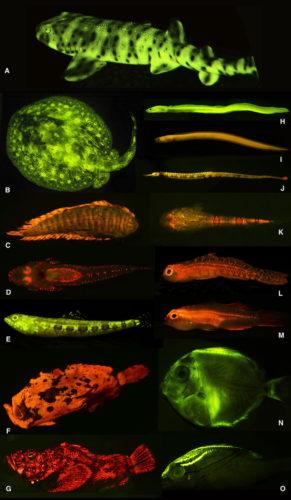Fish have an amazing feature! They fluoresce! And this phenomenon is more widespread than previously thought!

A team of researchers led by scientists from the American Museum of Natural History has released the first report of widespread biofluorescence in the tree of life of fishes, identifying more than 180 species that glow in a wide range of colors and patterns. I am wondering if these ones also fluoresce.

Diversity of fluorescent patterns and colors in marine fishes.
A, swell shark (Cephaloscyllium ventriosum); B, ray (Urobatis jamaicensis); C, sole (Soleichthys heterorhinos); D, flathead (Cociella hutchinsi); E, lizardfish (Synodus dermatogenys); F, frogfish (Antennarius maculatus); G, false stonefish (Scorpaenopsis diabolus); H, false moray eel (Kaupichthys brachychirus); I, false moray eel (Kaupichthys nuchalis); J, pipefish (Corythoichthys haematopterus); K, sand stargazer (Gillellus uranidea); L, goby (Eviota sp.); M, goby (Eviota atriventris); N, surgeonfish (Acanthurus coeruleus, larval); O, threadfin bream (Scolopsis bilineata)
The research shows that biofluorescence—a phenomenon by which organisms absorb light, transform it, and eject it as a different color—is common and variable among marine fish species, indicating its potential use in communication and mating. The report opens the door for the discovery of new fluorescent proteins that could be used in biomedical research.
To learn more about this study, visit amnh.org.












[…] Do you know that fish also emit bioluminescence? […]
[…] Do you know that there are plenty of bioluminescent fish? […]
[…] of light by a living organism) in known to be used by many species of algae, zooplanktons and fish around the world. This post brings you to the Emas National Park in Brazil, where luminous beetle […]